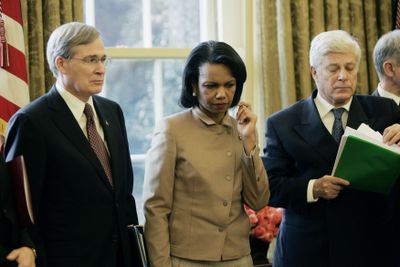U.S. spied on Iraq’s leader, book claims
Covert techniques, more than surge, get credit for progress

WASHINGTON – The Bush administration has conducted an extensive spying operation on Prime Minister Nouri al-Maliki, his staff and others in the Iraqi government, according to a new book by Washington Post editor and author Bob Woodward.
“We know everything he says,” according to one of multiple sources Woodward cites about the practice in “The War Within: A Secret White House History, 2006-2008,” scheduled for publication by Simon & Schuster on Monday.
The book also says that the U.S. troop “surge” of 2007, in which President Bush sent nearly 30,000 additional U.S. combat forces and support troops to Iraq, was not the primary factor behind the steep drop in violence there during the past 16 months.
Rather, Woodward reports, “groundbreaking” new covert techniques, beginning in 2007, enabled U.S. military and intelligence officials to locate, target and kill insurgent leaders and key individuals in extremist groups such as al-Qaida in Iraq.
Woodward does not disclose the code names of the covert programs or provide much detail about them, saying in the book that White House and other officials cited national security concerns in asking him to withhold specifics. But he quotes “several authoritative sources” as saying that “85 to 90 percent of the successful operations and ‘actionable intelligence’ had come from” the breakthrough techniques.
Overall, Woodward writes, four factors combined to reduce the violence: the covert operations; the influx of troops; the agreement by militant cleric Muqtada al-Sadr to rein in his powerful Mahdi Army; and the so-called Anbar Awakening, in which tens of thousands of Sunnis turned against al-Qaida in Iraq and allied with U.S. forces.
The 487-page book is Woodward’s fourth to examine the inner debates of the Bush administration and its handling of the wars in Iraq and Afghanistan.
The book concentrates on Bush’s leadership and governing style, based on more than 150 interviews with the president’s national security team, senior deputies and other key players in the intelligence, diplomatic and military communities. Woodward conducted two on-the-record interviews with Bush in May.
The book portrays an administration riven by dissension, either unwilling or slow to confront the deterioration of its strategy in Iraq during the summer and early fall of 2006. Publicly, Bush maintained that U.S. forces were “winning”; privately, he came to believe that the military’s long-term strategy of training Iraq security forces and handing over responsibility to the new Iraqi government was failing. Eventually, Woodward writes, the president lost confidence in the two military commanders overseeing the war: Gen. George W. Casey Jr., then commander of coalition forces in Iraq, and Gen. John Abizaid, head of U.S. Central Command,
In October 2006, the book says, Bush asked Stephen Hadley, his national security adviser, to lead a closely guarded review of the Iraq war. That first assessment did not include anyone from the military, however, and proceeded secretly because of White House fears that news coverage of a review might damage Republican chances in the midterm congressional elections.
“We’ve got to do it under the radar screen because the electoral season is so hot,” Hadley is quoted as telling Secretary of State Condoleezza Rice, who is described as challenging the president on the wisdom of sending additional troops to Iraq when “we’re not getting a clear picture of what’s going on on the ground.”
The quality and credibility of information about the war’s progress became a source of ongoing tension within the administration, according to the book. Rice complained about the Defense Department’s “overconfident” briefings during the tenure of Secretary Donald Rumsfeld. Rather than receiving options on the war, Bush would get “a fable, a story … that skirted the real problems,” Rice is quoted as saying.
According to Woodward, the president maintained an odd detachment from the reviews of war policy during this period, turning much of the process over to Hadley. “Let’s cut to the chase,” Bush told Woodward. “Hadley drove a lot of this.”
Nor, Woodward reports, did the president express much urgency for change during the months when sectarian killings and violent attacks against U.S. forces in Iraq began rising, reaching more than 1,400 incidents a week by October 2006 – an average of more than eight an hour. “This is nothing that you hurry,” he told Woodward during one of the interviews, when asked whether he had given his advisers a deadline for revising the war strategy.
Responding to a question about how the White House settled on a troop surge of five brigades after the military leadership in Washington had reluctantly said it could provide two, Bush said: “OK, I don’t know this. I’m not in these meetings, you’ll be happy to hear, because I got other things to do.”